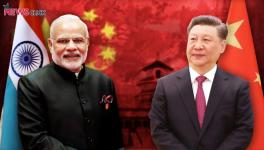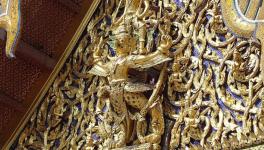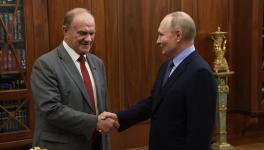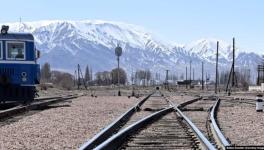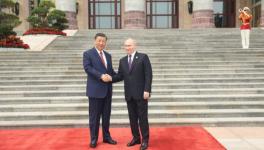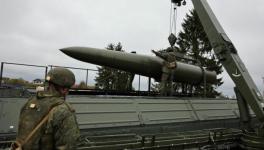The US-NATO Invasion of Libya Destroyed the Country
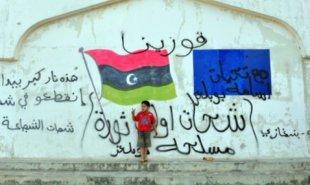
Photo Credit: thomas koch/Shutterstock
On Friday, March 17, hundreds of Libyans came into Tripoli’s Martyrs’ Square. They wanted to make a simple statement: end the rule of militias. Since the NATO war of 2011, Libya has been ruled by a patchwork of rival heavily armed gangs that have sown terror in the population. Gunfights are common – as had been experienced these past ten days across Tripoli. The Rixos Hotel – which had served as the government’s building – faced heavy shelling, with tanks and snipers racing to destroy this beautiful city. Burning cars blocked roads, as children stayed home from school and shops were shuttered. The protesters came to say – enough. They wanted the fighting to end. It was inevitable that gunfire would scatter them into nearby buildings, Libyan flags fluttering above them in the breeze. These militias – now entrenched across the country – are not going to be easy to dismantle.
Frustrated Libyans in Tripoli point across the country towards the eastern city of Benghazi and vest their hopes in General Khalifa Haftar. ‘He can save us’, said an old friend who has weathered the violence and chaos since NATO’s war of 2011. It meant little to this man that General Haftar had lived for twenty years in the shadow of the CIA’s offices in Virginia after he had defected from the Libyan Army. It meant even less that he had arrived in Benghazi during the early days of the 2011 war in Libya and that he had sought leadership of the rag-tag army – backed by NATO. My friend is an old socialist with fond memories of the high point of the Qaddafi era. Haftar, whom Qaddafi once called a ‘son’, had betrayed his leader in the aftermath of Libya’s defeat in the 1987 Toyota War against Chad and defected to the United States. But this meant nothing. Times are different now. Even Haftar, the leader of the self-styled Libyan National Army (LNA), has come to promise hope against the archipelago of militias. Haftar hastily went on television right after the gunfire at Martyrs’ Square. ‘Your armed forces will not abandon you,’ he said ceremoniously, ‘and we will be by your side until Tripoli is returned to the homeland.’
Over the past few years, Haftar – ensconced in Benghazi – has fashioned himself as a strongman, a military man with no patience for either the al-Qaeda linked Ansar al-Sharia or the Muslim Brotherhood. Ignored by the United States – his early patron – Haftar has turned to Egypt, the United Arab Emirates and Russia for support. There was room there for eager ears, since those powers are partial to Haftar’s self-image as the strongman. Haftar does not look back to the secular nationalism of Gamel Abdul Nasser for inspiration, but resembles the farcical patriotism of Abdel Fattah el-Sisi. Russia looks fondly on both these men – Haftar and Sisi – for both promise military-style stability that would crush any whiff of political Islam.
But for all Haftar’s braggadocio, it is important to recognize that his LNA has had only mixed results in the battlefield. In May 2014, Haftar’s LNA opened up a war against the various extremist groups in Benghazi. The battle was called Operation Karama (Dignity), a sly allusion to the early days of the ‘Arab Spring’ when dignity was the cry on the lips of the protestors. But Operation Karama, despite the LNA’s superior firepower (including Egyptian and Emirati fighter jets) has not been able to trounce the Revolutionary Shura Council of Benghazi (whose main component is the al-Qaeda backed Ansar al-Sharia). The day after last Friday’s fracas in Tripoli, the LNA was able finally to oust the Shura Council fighters from the southwest of Benghazi. The Shura Council’s fighters still hold key northern parts of the city – namely the areas of al-Sabri and Souq al-Hout – not far from Benghazi’s port. It will not be easy for the LNA to remove the Shura Council from these congested areas without a great many civilian casualties.
Not far from Benghazi, along Libya’s coastline, a battle has raged over the oil installations that are key to the wealth of this oil-rich country. Over the past few years, thousands of fighters in the Petroleum Facilities Guard have held the oil terminals in Ras Lanuf, Sidra and Zueitina. They were led by Ibrahim Jadran, a former car thief who has now styled himself as a leader of the secessionist movement for eastern Libyan (called Cyrenaica after its old Roman name). But Jadran’s aims are more prosaic. He has tried to sell the oil by himself, and has run afoul of the United States and of the UN-recognized government that sits in Tripoli. Haftar’s LNA pushed Jadran’s forces out of these key positions in September last year. It was this thrust along the coastline that earned Haftar’s LNA a great deal of respect in the country, and much delight in Cairo and in Abu Dhabi.
Saudi Arabia arrived on the scene to block the ambitions of Haftar and his backers. The Kingdom had its own proxies, mainly refracted through the repellent Grand Mufti of Tripoli, Sadeq al-Ghariani. It was the Saudi-backed groups that created the Benghazi Defense Brigade militia in June of 2016 – an extremist group set up to fight Haftar’s LNA and provide space for the Kingdom to assert itself in Libya’s dangerous battlefields. ISIS fighters, expelled from the city of Sirte, are now fighting alongside the Shura Council in their northern redoubts of Benghazi, while Shura Council fighters have joined the Benghazi Defense Brigade and some militias from the western town of Misrata – both groups in and outside Benghazi battling Haftar’s LNA. These Brigades have taken refuge in the district of Jufra, south of the oil installations, lashed by dust storms that pay no heed to the petroleum beneath the desert. Saudi Arabia’s proxies have blocked the LNA advance to the southern city of Sabha and provided problems in the oil areas. For ten days in March, the Benghazi Defense Brigades seized the oil installations from Haftar. But Haftar’s forces – strengthened by air cover – took them back on March 13. Little gain for Saudi Arabia in this feint. But this battle is far from over.
Enter the Russians.
Haftar dashed off to see the Russians about weaponry and assistance. He has fair-weather friends amongst the Europeans. Occasionally the Italians have provided Haftar with intelligence, but their allegiance remains with the UN-backed government that appears more and more like a shadow of its expectations. The Russians were pleased to receive Haftar aboard their aircraft carrier – Admiral Kuznetsov – in January. From the ship, Haftar spoke to the Russian defense minister Sergey Shoygu. Haftar had been in Moscow last November, when it was reported that he had discussed arms deals. It was during the conversation with Shoygu that Haftar was able to get Russian confirmation for a $2 billion arms deal. These weapons will give the LNA much greater firepower than possessed by the Shura Council, the Benghazi Defense Brigades and other militia groups.
Russia has said repeatedly that it wants to see a ‘strong power’ emerge in Libya. This has been taken to mean that they would like to see Haftar establish a Sisi-type state in the country. Last December, Russia’s Deputy Foreign Minister Gennady Gatilov said, ‘We believe that the Libyans have to find a compromise on Haftar’s participation in the new Libyan leadership.’ At that time the UN’s envoy to Libya – Martin Kobler – called upon UN member states not to ‘strike separate deals with parts of the Libyan political establishment behind the back of other influential players.’ Everyone knew that Kobler meant the Russians and Haftar. But by February Kobler was singing a different tune. ‘The single most important topic is the construction of a Libyan united army with a clear chain of command, where General Haftar must have a role,’ he told Reuters. It appears that Haftar has now arrived.
Strikingly, reports now come that the Russians have deployed forces into Egypt – with bases established in Sidi Barrani (about 60 miles from the Egyptian-Libyan border) and Marsa Matruh – both fabled sites of battles between the Allies and the Axis during World War II. The Egyptians have, of course, officially denied the Russian presence, but well-informed people say that it is likely to be true. Last October, Russian and Egyptian forces began to conduct joint military exercises, and Russian military officials have indicated that they would like to have access to a base in Egypt. This suggests that it might not be impossible that Russian forces are inside Egypt, ready to assist Hafter if the need arises.
A dent in Haftar’s fortunes came this week when video was released of LNA fighters exhuming the bodies of their adversaries from the Benghazi Defense Brigades. These gory videos show the LNA fighters mutilating the bodies not only of fighters, but also of civilians. Denunciations by the LNA hierarchy could not erase the images of brutality. Hard to position oneself as the savior of the nation if this is the caliber of the soldiers.
The UN’s Martin Kobler warned of a ‘dangerous escalation’ in Libya. That phrase sounds shopworn. It has been used so often. There is no end to the war. Like a moving kaleidoscope the fighters change sides. Their loyalties are hard to read. It is even harder to understand the suffering of the people. At NATO headquarters they still smirk about their successful war in Libya. It is a war that broke this country.
Disclaimer: The views expressed here are the author's personal views, and do not necessarily represent the views of Newsclick.
Get the latest reports & analysis with people's perspective on Protests, movements & deep analytical videos, discussions of the current affairs in your Telegram app. Subscribe to NewsClick's Telegram channel & get Real-Time updates on stories, as they get published on our website.










